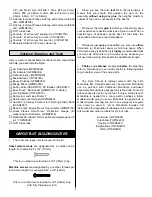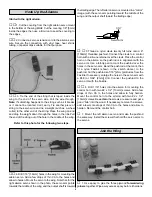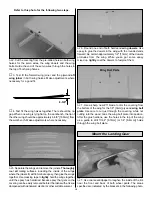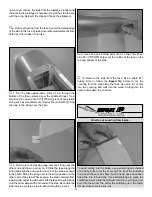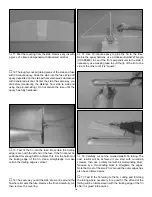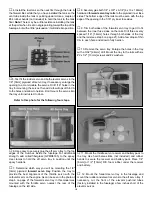
Though technically the Ryan STA-M is considered a
“giant-scale” model, it does not require the same “heavy-
duty” equipment as other truly giant planes. The only “heavy-
duty” equipment suggested for this model is three servos
that have 50 oz.-in. [3.3 kg-cm] or more of torque (one for
the rudder and two for the elevators). The ailerons and
throttle may be operated by standard servos.
Because the Ryan STA-M uses dual elevator servos and
because the servos must move in opposite directions (due to
the way they are mounted in the fuse), they cannot be
connected with a “Y” connector (unless you have a “reverse”
servo). Therefore, to fly the Ryan, a radio system capable of
electronic servo mixing is required, so that one of the
elevator servos can be reversed. If you do not have a radio
with programmable mixing, the Futaba
®
SR-10 Synchronized
Servo Reverser (FUTM4150) may be used. When both
elevator servos are connected to this device, they operate in
opposite directions. The Synchronized Servo Reverser is
compatible with most popular radio systems.
A receiver battery with a capacity of at least 1000 mAh is
also recommended for this model.
There are several engines that will work well in the Ryan
STA-M ARF. The official engine size recommendation range is
.61 - .91 cu in [10.0 - 15.0cc] two-stroke or .91 - 1.20 cu in
[15.0 - 20.0cc] four-stroke. If an engine in the upper end of the
size range is selected, remember that this is a scale model
that is intended be flown in a scale manner at scale speeds,
so prudent throttle management must be practiced. Our
prototype, powered by an O.S.
®
MAX .91 FS with a 14 x 6
prop, flew smoothly and most scale-like at about 3/4 throttle.
Refer to your engine manufacturer's recommendations for the
correct size propeller. Note: With the O.S. MAX .91 four-stroke
used in this model, the O.S. “in” type exhaust header pipe
(OSMG2624) was used to position the muffler so an exhaust
hole did not have to be cut in the cowl.
This kit includes a 2-3/4" aluminum spinner with a 10-32
spinner bolt. Due to the variety of engines that may be used
on the Ryan, an adapter kit for mounting the spinner is not
included with this kit and must be purchased separately. For
the O.S. .61 SF, SX and other two-stroke engines with a
5/16"-24 crankshaft thread purchase Spinner Adapter Kit
#GPMQ4584. For the O.S. .91 to 1.20 four-strokes and other
four-strokes with a 5/16"-24 crankshaft thread purchase
Spinner Adapter Kit #GPMQ4588. If neither of these adapter
kits will suit your engine, another brand of adapter kit (that
includes both the prop nut and the spacer ring for the back
plate of the spinner - such as Tru-Turn) must be purchased.
In addition to the items listed in the “Decisions You Must
Make” section, following is the list of hardware and
accessories required to finish the Ryan. Order numbers are
provided in parentheses.
❏
(2) 24" [610mm] Servo extensions for ailerons
(HCAM2200 or HCAM2721 for Futaba
®
)
❏
(1) 6" [150mm] Servo extension for aileron (HCAM2000
or HCAM2701 for Futaba)
❏
(1) “Y” connector for ailerons (FUTM4130 for Futaba)
❏
Suitable propeller and spare propellers
❏
Medium Fuel Tubing (GPMQ4131)
❏
Switch & Charge Jack Mounting Set (GPMM1000)
❏
Fuel filler valve for glow fuel (GPMQ4160)
❏
R/C foam padding (1/4" [6mm] HCAQ1000, or 1/2"
[13mm] HCAQ1050)
❏
(2) Williams Bros. #62500 1/4-scale Standard pilots
(WBRQ2625)
❏
Olive Drab paint for cockpit and paint for pilots
❏
Model Products #021 Remote glow plug adapter
(MODP1221)
❏
1/4" [6mm] Kwik Stripe silver striping tape (GPMQ1244)
❏
#64 rubber bands (for mounting fuel tank)
In addition to common household tools and hobby tools, this
is the “short list” of the most important items required to build
the Ryan.
Great Planes Pro
™
CA and Epoxy glue
are recommended.
❏
1/2 oz. Thin CA (GPMR6002)
❏
1/2 oz. Medium CA (GPMR6008)
❏
CA Applicator Tips (HCAR3780)
❏
30-Minute Epoxy (GPMR6047)
❏
Milled Fiberglass (GPMR6165)
❏
Threadlocker (GPMR6060)
❏
50" [1270mm] of K&S #801 Kevlar thread (K+SR4575) or
non-elastic monofilament line for stab alignment
❏
Builders Triangle Set (HCAR0480) (for fin alignment)
❏
Masking Tape (TOPR8018)
❏
Silver solder (GPMR8070)
❏
Small metal file
❏
English size drill bits: 1/16", #48 (or 5/64"), 3/32", #36 (or
7/64"), 1/8", #29 (or 9/64"), 5/32", 3/16", 7/32", 17/64" (or
Adhesives and Building Supplies
Hardware and Accessories
ADDITIONAL ITEMS REQUIRED
Spinner Adapter Kit
Engine Recommendations
Radio Equipment
DECISIONS YOU MUST MAKE
4





